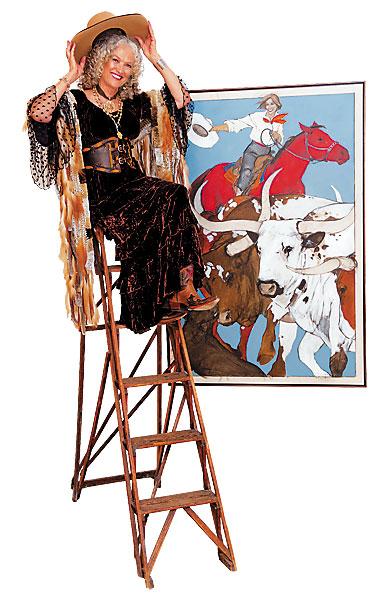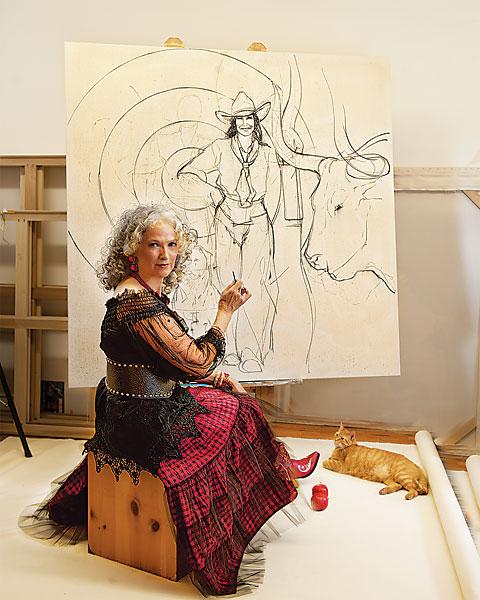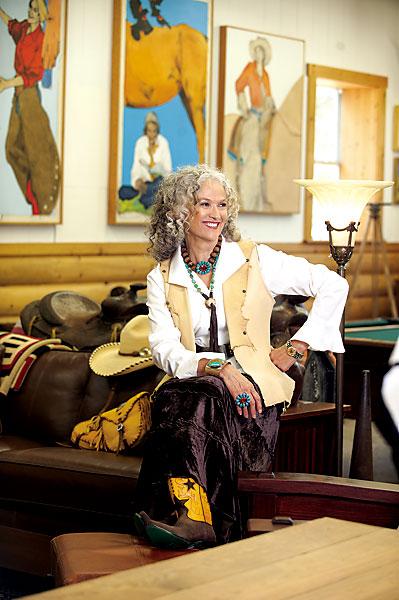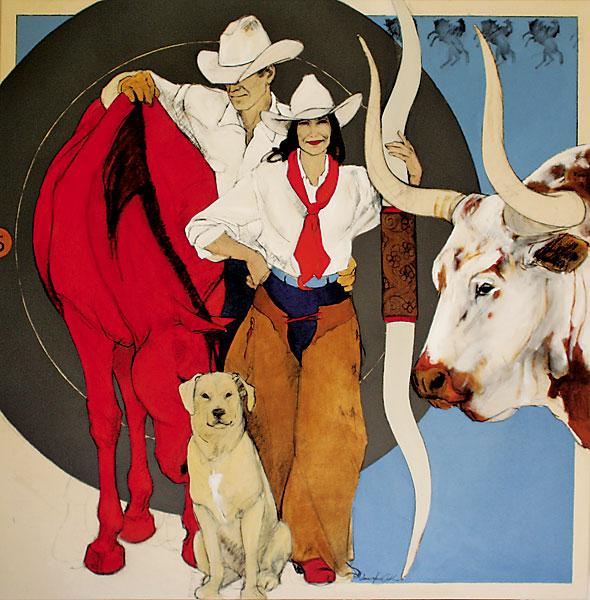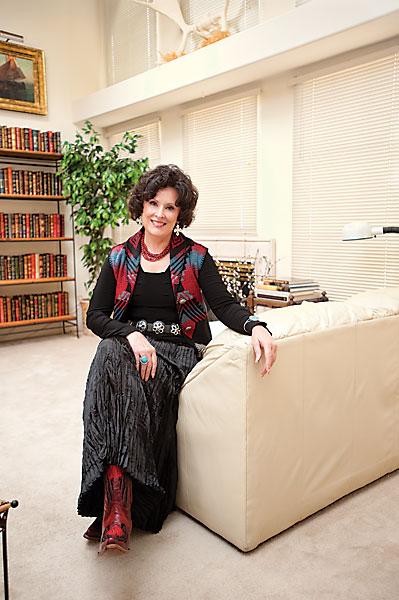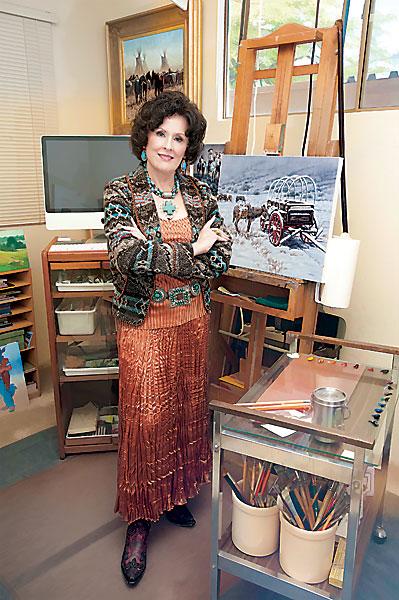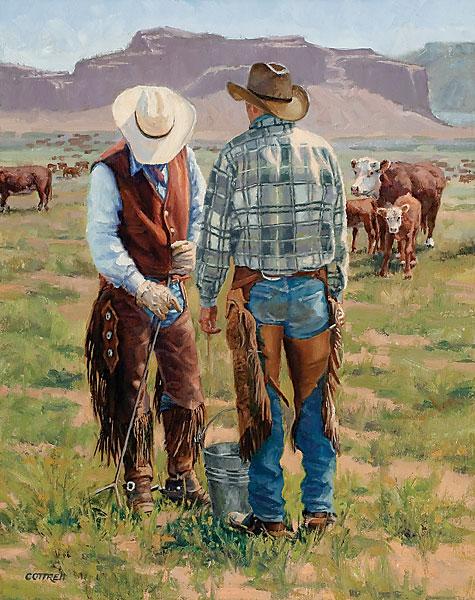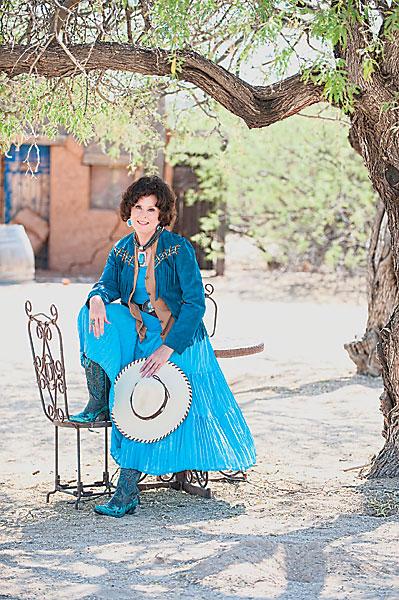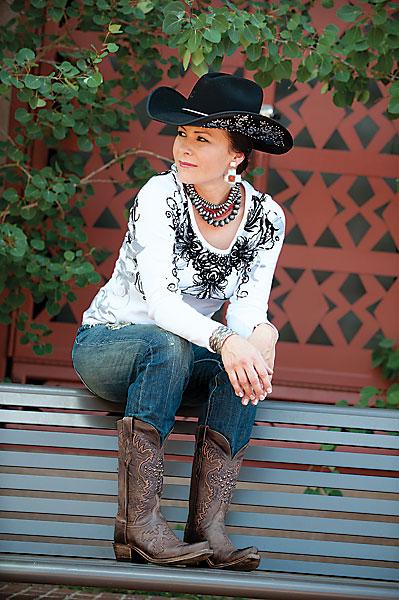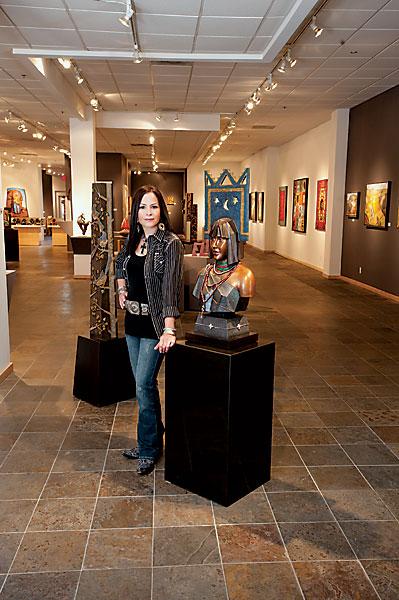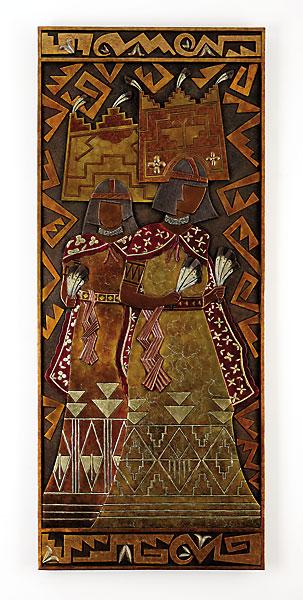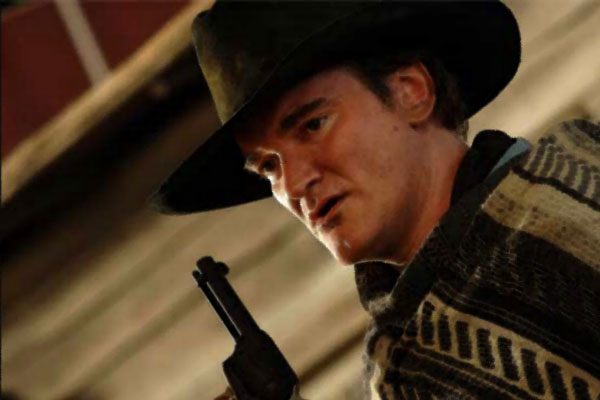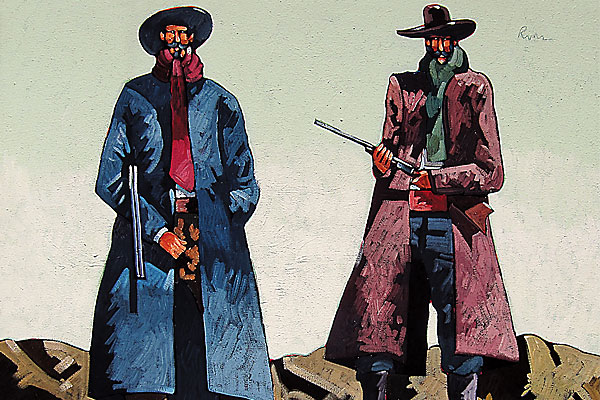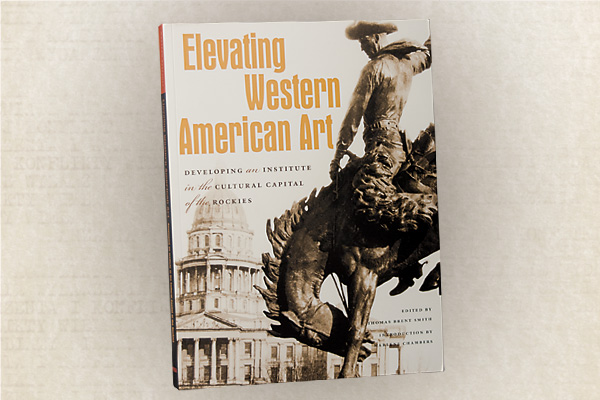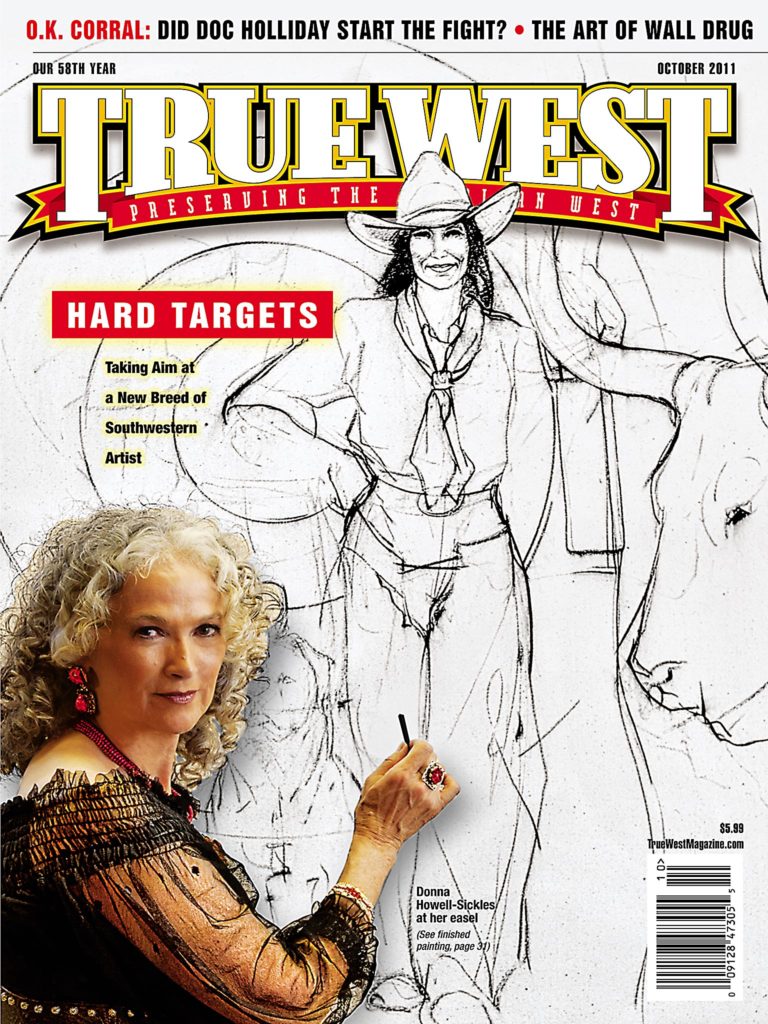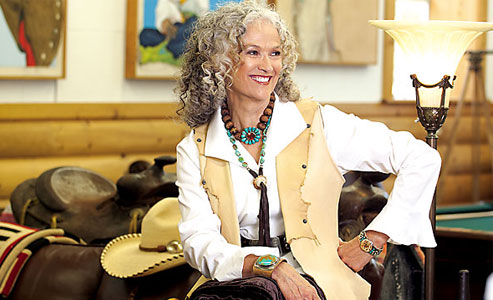 Western style, like Western art, is largely indefinable, but always recognizable.
Western style, like Western art, is largely indefinable, but always recognizable.
Sure, the two feature plenty of distinct clichés and landmarks—pointed yokes and snowcapped mountains, wide-brimmed hats and broad horizons, denim jeans and star-filled night skies—but the raw and wild aspect to “things Western” is what evokes the nature of the place. Western art and fashion are instinctive, primal and understood by anyone who appreciates the nature and history of the West.
To gain insight into those raw and wild aspects, we invited three incredible female artists of the West to share with us their distinctive styles in both their artworks and their fashion.
Donna Howell-Sickles
The work of Texas artist Donna Howell-Sickles showcases colorful and whimsical cowgirls who gambol and cartwheel across canvases in boisterous celebration of the West and their lives in it: they are Technicolor tumbleweeds bouncing across an undefined prairiescape. Turned out in oversized hats, wild rags and leather chaps, Howell-Sickles’ women capture the exuberance and optimism native to the American West and to Westerners. Her work has earned her a spot in the pantheon of Western women celebrated in the National Cowgirl Museum & Hall of Fame in Fort Worth, Texas.
Howell-Sickles’ paintings are infused with mythology and magic, sometimes borrowing from a European nursery rhyme, sometimes evoking American Indian lore, but always telling a tale in the lingo of cowhands sitting around a campfire.
Her cowgirls wear a uniform of sorts: a plain shirt with sleeves rolled up ready for action, an oversized hat and jeans tucked into boots. She rolls up the sleeves of her subjects to make the arms and hands more expressive, and she often includes chaps over jeans or jodhpurs and a knotted bandanna. “I select clothes to shape the figure,” Howell-Sickles says of the wardrobes worn by her cowgirls. “Jodhpurs broaden hips; chaps bisect the figure. Wild rags are a great excuse for color, and the knots have cultural, practical and
mystical implications.”
Like her cowgirls, Howell-Sickles tends to wear solid shirts, and she has an extensive collection of cowboy boots. She owns three cowgirl hats, but seldom wears them due to her luxuriant, curly hair. She also wears a lot of jewelry—a conspicuous contrast to her cowgirls. She reasons that working cowgirls can’t wear much jewelry on the job, and jewelry would just clutter up a painting, adding philosophically, “Sometimes less is better.”
Sheila Cottrell
Family heritage and history infuse the paintings of Sheila Cottrell. Born and raised in southern Arizona, Cottrell has Western roots reaching back to early 1800s Texas, where ancestors homesteaded before migrating west to Cochise County as the 1900s dawned. Working with subjects ranging from prairie schooners fording swollen rivers, to cowboys at work and play, to serene landscapes, Cottrell says authenticity is essential to her work. But she does admit to a nostalgic streak that turns up in her paintings and her personal life and style.
The clothes worn by her subjects are based on personal family photos, photos taken at recent brandings and rodeos, and photos sent by friends and fans. “They’ll send me old photos from roundups,” she says. She likes painting historical portraits, including Indians whose primitive styles and colors were less complicated. As for cowboy themes, she notes that “contemporary workwear hasn’t changed that much” from what was worn 50 and even 80 years ago.
Her personal style reflects her romantic ideals about the Old West. “I used to design and style my own clothes, especially dressier clothes,” she says. Her preference for simpler times seems to extend to her wardrobe, which she says is made up of “classic, simple” styles. “I might have a print in my closet,” she teases.
Tammy Garcia
Coming from a distinguished line of potters from the Santa Clara Pueblo in New Mexico, Tammy Garcia produces exquisitely designed pottery, bronze statuary, glasswork and jewelry. She transforms traditional American Indian and Western themes with contemporary designs and forms that result in unique, elegant and timeless pieces of art.
A restless artist at heart, always looking for new forms of expression, Garcia reveals her latest project is hand carving forms she says mimic “perfume bottles.” The bottle concept was influenced by perfume ads in Vogue and other fashion magazines. “Fashion is a huge part of what I do,” Garcia says. “I look at how colors relate to one another; how patterns, textures and colors
all interact.”
She says her personal style is as eclectic and uncommon as her art. Her clothes include Western and mainstream styles, which she intermixes at will. “We’re blessed to live in this country with choices,” Garcia says. “All too often we find ourselves caught up in rules—somebody else’s idea of what’s right and what’s wrong. I intentionally try to be contrary, bend the rules, find new directions.”
G. Daniel DeWeese coauthored the book Western Shirts: A Classic American Fashion (Gibbs Smith, 2004). Ranch-raised near the Black Hills in South Dakota, Dan has written about Western apparel and riding equipment for more than 25 years.
Photo Gallery
Donna Howell-Sickles wears a chocolate velvet peasant top with lace sleeves ($189) and a princess layered skirt ($425) by Marrika Nakk; a vintage rodeo cowgirl belt by Gunslinger ($425); a rabbit and fox wrap by Pat Dahnke ($395); chocolate Golondrita boots with rose-colored flowers and swallows by Old Gringo ($589); a mocha felt, flat crowned hat with a chocolate ribbon trim and matching hat band, made custom by Greeley Hat Works for Gunslinger ($359); and a beaded layered necklace ($190) with a rose pendant ($139) by Coreen Cordova.
–Fashion images by Lucinda Amorosano
– Special thanks to Melissa Benge from Gunslinger in Bandera, Texas, for providing all apparel for the Donna Howell-Sickles photo shoot –
Donna Howell-Sickles sometimes feels like she’s a target. This emotion inspired her to create the above painting, Right on Target; she was working on it when we captured her in the next slide show. To find out why she feels that way, watch our interviews with her, Sheila Cottrell and Tammy Garcia.
Artist at Work:
Tammy Garcia’s bronze sculpture, Panshara, reflects her Santa Clara Pueblo culture; her other art mediums include blown glass, pottery and jewelry.


